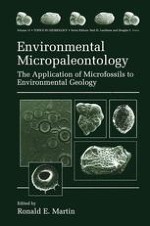2000 | OriginalPaper | Buchkapitel
Ostracoda in Detection of Sewage Discharge on a Pacific Atoll
verfasst von : Stephen H. Eagar
Erschienen in: Environmental Micropaleontology
Verlag: Springer US
Enthalten in: Professional Book Archive
Aktivieren Sie unsere intelligente Suche, um passende Fachinhalte oder Patente zu finden.
Wählen Sie Textabschnitte aus um mit Künstlicher Intelligenz passenden Patente zu finden. powered by
Markieren Sie Textabschnitte, um KI-gestützt weitere passende Inhalte zu finden. powered by
Ostracoda have long been known to be useful as indicators of variations in the environment, such as salinity, pH, Eh, and temperature, and more recent studies have focused on pollution. Initially, these studies concentrated on freshwater species and, indeed, most of the subsequent work has also been done using freshwater species. Ostracodes were used to show the influence of a sewage discharge into a stream in Israel (Rosenfeld and Ortel, 1983). Later, other studies worked on the effects of pesticides on freshwater species in ricefields (Lim and Wong, 1986). Pioneering work was done in France by Bodergat (1978) on the effects of cerium on the environment through studying the valves of marine water species and also on the effects of industrial and urban water from a large city in Japan on the marine ostracodes (Bodergat and Ikeya, 1988). Another study by Bodergat et al. (1997) was done on natural pollution or eutrophication. Following changes observed in the faunas at Tarawa Atoll, Republic of Kiribati, (Eagar, 1998), where the number of species had recently declined, a study was undertaken in New Zealand on the extreme situation, of a direct sewer discharge from a large city into the marine environment (Eagar, 1999; see also in this volume Ebrahim, Ch. 4; Hallock, Ch. 5; Rosenfeld et al., Ch. 7; Schomhikov, Ch. 8; Ishman, Ch. 16).
